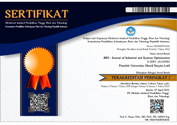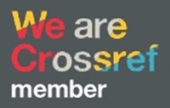PENENTUAN RUTE DISTRIBUSI UNTUK MEMINIMALKAN BIAYA PENGIRIMAN TAS FASHION DI UD. SUWARLANDONO
DOI:
https://doi.org/10.51804/jiso.v5i2.%25pKeywords:
algoritma sweep, distribusi, mixed integer linear progammingAbstract
ABSTRAK
UD. Suwarlandono ialah perusahaan yang berkecimpung pada sektor pembuatan tas fashion yang berada di Kec. Tanggulangin, Kab. Sidoarjo. Pendistribusian barang dilakukan menggunakan armada milik pribadi dengan tujuan pengiriman yang tersebar di Wilayah Surabaya, Sidoarjo, dan Malang. Namun ditengah proses pengiriman tersebut dapat dikatakan tidak efektif bahkan cenderung mengakibatkan pemborosan biaya, karena setiap armada yang digunakan pada saat setelah melakukan pengiriman di lokasi kedua selalu kembali ke gudang untuk mengambil barang dan dikirimkan menuju lokasi distributor selanjutnya. Hal ini disebabkan pihak perusahaan masih belum bisa memaksimalkan kapasitas armada dan tidak memiliki system pengiriman yang baik, di studi ini penulis menjalankan penetapan rute memanfaatkan pendekatan Algoritma Sweep guna mengcluster semua distributor lalu menciptakan rute melalui capaian cluster itu guna mencari jumlah jarak minimal dan selanjutnya memanfaatkan model matematis mempergunakan konsep Mixed Integer Linear Programming mempergunakan software Lingo 13.0 x64. Sesuai capaian olah data didapat hasil rute yang optimal dengan menghemat jarak sebesar 27% yaitu 233 km dan biaya sebesar 11% yaitu Rp 217.250
ABSTRACT
UD. Suwarlandono is a company engaged in the manufacture of fashion bags located in the district. Tanggulangin, Kab. Sidoarjo. The distribution of goods is carried out using privately owned fleets with the aim of sending them to the Surabaya, Sidoarjo, and Malang areas. However, in the midst of the delivery process, it can be said to be ineffective and even tend to result in wasted costs, because every fleet used after making a delivery at the second location always returns to the warehouse to pick up goods and send it to the next distributor location. This is because the company still has not been able to maximize fleet capacity and does not have a good delivery system, in this research the authors determined the route using the Sweep Algorithm approach to cluster all distributors and then create a route through the yield of the cluster to find the minimum total distance and then use mathematical model with the concept of Mixed Integer Linear Programming using Lingo 13.0 x64 software. Based on yield, the optimal route results by saving the distance by 27%, which is 233 km and costs by 11%, which is Rp. 217,250.
References
Eric Wibisono. (2018). Logika Logistik. Graha Ilmu.
Gugus Wijonarko, M. (2021). LOGISTIK & SUPPLY CHAIN MANAGEMENT. KYTA, Anggota IKAPI.
Manajemen, J., & Suwarno, H. L. (2006). Sembilan Fungsi Saluran Distribusi?: Kunci Pelaksanaan Kegiatan. 6(1), 79–87.
Prasetyo, W., & Tamyiz, M. (2017). Vehicle Routing Problem Dengan Aplikasi Metode Nearest Neihbor. Journal of Research and Technology, 3(2).
Ratih Endayani. (2011). Mari Berkenalan dengan Manajemen Logistik. ALFABETA, cv.
Ricky Virona Martono. (2018). Manajemen Logistik. PT Gramedia Pustaka Utama.
Siboro, B., ’ J., & Noviasari, H. (2014). Analisis Strategi Saluran Distribusi Minyak Pelumas Enduro Pada Pt. Arjuna Lumas Dwiguna Pekanbaru. Jurnal Online Mahasiswa Fakultas Ekonomi Universitas Riau, 1(2), 1–15.
Tulong, S. R., Tumbel, A. L., & Palandeng, I. D. (2016). Identifikasi Saluran Distribusi dalam Rantai Pasokan Kentang Di Kecamatan Modoinding (Studi di Desa Linelean). Jurnal EMBA, 4(1), 1562–1569.
Downloads
Published
Issue
Section
License
With the receipt of the article by JISO Editorial Board and the decision to be published, the copyright regarding the article will be transferred to JISO. The copyright transfer form can be downloaded here.
JISO has the right to multiply and distribute the article and every author is not allowed to publish the same article that was published in this journal.
JISO is licensed under a Creative Commons Attribution-ShareAlike 4.0 International License.
Under the following terms:
Attribution — You must give appropriate credit, provide a link to the license, and indicate if changes were made. You may do so in any reasonable manner, but not in any way that suggests the licensor endorses you or your use.
ShareAlike — If you remix, transform, or build upon the material, you must distribute your contributions under the same license as the original.














